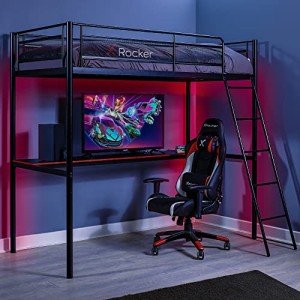Bunk Beds for Kids: A Comprehensive Guide
Bunk beds have been a popular choice for children's bed rooms for years. They provide a space-saving option that optimizes floor area, offers enjoyable climbing up options, and can be found in a range of styles that attract children's imaginations. This post checks out the advantages, factors to consider, designs, and security features related to bunk beds for children.
Advantages of Bunk Beds
Bunk beds present multiple advantages that make them an attractive option for households. Here are some crucial benefits:
Space Saving
- Bunk beds permit two or more kids to share a room without compromising space for play or other activities.
Cost-Effective
- Getting a single bunk bed can be more affordable than buying two different beds.
Enjoyable Factor
- Kids typically see bunk beds as an enjoyable location to sleep and play, fostering a sense of adventure.
Versatility
- Bunk beds are available in numerous setups, including L-shaped, loft beds, and even convertible designs that can alter as kids grow.
Company
- Numerous bunk beds feature integrated storage options, such as racks and drawers, helping keep rooms organized.
Key Considerations Before Purchasing
Before investing in a bunk bed, it's important to think about specific aspects, such as:
- Space Requirements
Procedure the space to guarantee that there suffices vertical space, permitting appropriate headroom on the top bunk. - Age of Your Children
Consider their age and maturity. Numerous manufacturers advise that children under 6 ought to not oversleep the top bunk due to safety issues. - Weight Limit
It's important to check the weight limitations of the bunk bed for both the top and bottom bunks to make sure safety. - Style Preferences
Select a style that matches the space's decoration and the kids's choices. - Material
Bunk beds are available in various products, such as wood or metal. Each has its benefits and drawbacks regarding durability and aesthetic appeals.
Styles of Bunk Beds
Bunk beds come in various styles to fit various visual appeals and practical requirements. Here's a list of some popular styles:
- Standard Bunk Beds
Traditional stacked beds that include 2 beds constructed one above the other. - Loft Beds
A bed raised high off the ground, with space beneath for a desk, play location, or storage. - L-Shaped Bunk Beds
2 beds set up in an L-shape, providing more floor space and an unique design component. - Twin Over Full Bunk Beds
These choices feature a twin bed on the top and a full-sized bed on the bottom, accommodating older kids or adults. - Triple Bunk Beds
Developed for three kids, these beds generally consist of 3 stacked beds, suitable for larger families.
Safety Features to Consider
Ensuring the safety of children utilizing bunk beds is critical. Here are some security features to search for before making a purchase:
- Guardrails
A bunk bed should consist of durable guardrails on the top bunk to avoid unintentional falls. - Ladders
Guarantee that the ladder is securely connected and easy for children to browse safely. - Stability
Try to find bunk beds with lower centers of gravity and wide bases to provide better stability. - Quality Construction
Select beds made from long lasting products that satisfy safety standards, such as ASTM (American Society for Testing and Materials) regulations.
FAQs About Bunk Beds
1. What age is suitable for a top bunk?Generally, children aged 6 and older are recommended for sleeping in the top bunk. 2. Are bunk visit the up coming webpage for toddlers?Most specialists advise versus
placing young children in the leading bunk due to the
danger of falls and inappropriate ladder usage. 3. Can bunk beds be separated?Many bunk beds are developed to be separated into two standalone beds,
providing included versatility as children grow
. 4. How do I maintain a bunk bed?Regularly check for loose screws and use, keep mattresses clean, and ensure that the bunk bed is
steady to prolong its lifespan. 5.
Are there any unique bed mattress requirements for bunk beds?Yes, bed mattress for bunk beds ought to fit snugly without leaving spaces. Typically, thinner mattresses
(around 6 to 8 inches )are suggested for top bunks for safety. Bunk beds use a flexible, useful, and enjoyable option for children's sleeping arrangements, optimizing space while accommodating multiple kids in one space. By thinking about the essential factors
of design, safety, and space, moms and dads can make a notified decision when picking the right bunk bed for their kids's requirements. With the best care and maintenance, a bunk bed can be a cherished piece of furnishings that supplies years of use and pleasure for children. Summary Table of Bunk Bed Styles Design Description Best For Standard Bunk Beds Classic style, 2 stacked beds Smaller rooms Loft Beds Elevated bed with open space beneath Research study or play areas L-Shaped Bunk Beds 2 beds in an L-shape
Added floor space Twin Over Full Twin on the top,
| complete on bottom Accommodating older kids Triple | ||||||
|---|---|---|---|---|---|---|
| Bunk Beds | 3 stacked beds | Larger families By comprehending | the different alternatives available, designated considerations for security and functionality, and suitable age standards, households | can choose the ideal bunk bed that not | only improves their living space | but likewise guarantees a safe and |
| enjoyable sleeping environment | for their kids.

|
